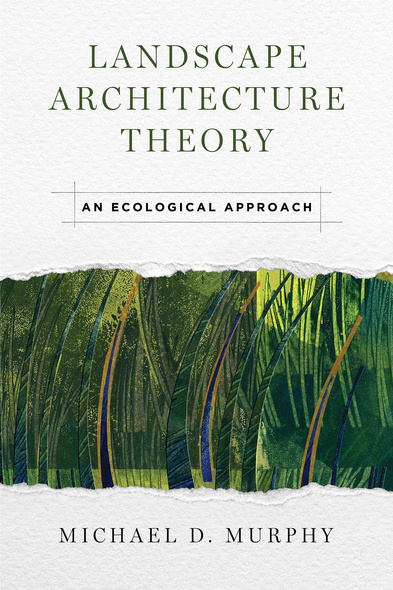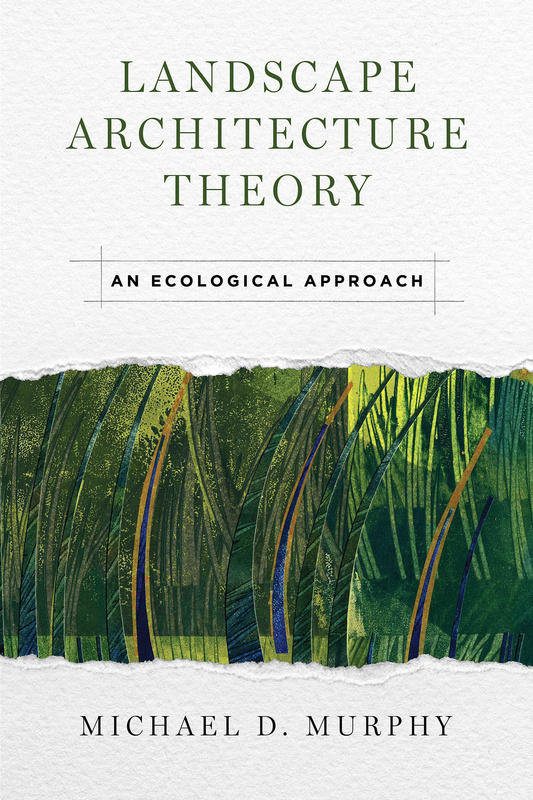
336 pages, 6 x 9
20 photos, 40 illustrations
Paperback
Release Date:13 Dec 2016
ISBN:9781610917513
For decades, landscape architecture was driven solely by artistic sensibilities. But in these times of global change, the opportunity to reshape the world comes with a responsibility to consider how it can be resilient, fostering health and vitality for humans and nature. Landscape Architecture Theory re-examines the fundamentals of the field, offering a new approach to landscape design.
Drawing on his extensive career in teaching and practice, Michael Murphy begins with an examination of influences on landscape architecture: social context, contemporary values, and the practicalities of working as a professional landscape architect. He then delves into systems and procedural theory, while making connections to ecosystem factors, human factors, utility, aesthetics, and the design process. He concludes by showing how a strong theoretical understanding can be applied to practical, every-day decision making and design work to create more holistic, sustainable, and creative landscapes.
Students will take away a foundational understanding of the underpinnings of landscape architecture theory, as well as how it can be applied to real-world designs; working professionals will find stimulating insights to infuse their projects with a greater sense of purpose.
Drawing on his extensive career in teaching and practice, Michael Murphy begins with an examination of influences on landscape architecture: social context, contemporary values, and the practicalities of working as a professional landscape architect. He then delves into systems and procedural theory, while making connections to ecosystem factors, human factors, utility, aesthetics, and the design process. He concludes by showing how a strong theoretical understanding can be applied to practical, every-day decision making and design work to create more holistic, sustainable, and creative landscapes.
Students will take away a foundational understanding of the underpinnings of landscape architecture theory, as well as how it can be applied to real-world designs; working professionals will find stimulating insights to infuse their projects with a greater sense of purpose.
As Kurt Lewin observed, 'There is nothing so practical as a good theory.' Landscape architecture is a discipline which has benefitted greatly from a few good theories, including, 'parks are good for people' and 'design with nature.' Even so, theory in the field has not been well organized or systematically understood. With this fine book, Michael D. Murphy wonderfully fills these gaps. Landscape Architecture Theory provides a valuable resource for scholars, students, and practitioners to understand how the discipline can help guide change to improve the human condition.
An instructional, highly-narrative book that strikes on the fundamentals while stepping lightly through complex subjects...This distillation of a huge number of important ideas into a quick and coherent format is the blueprint for a go-to book. Landscape Architecture Theory is eminently useful and widely applicable...There is not a single landscape architecture student who wouldn't benefit from reading this book cover to cover, and general readers will appreciate its simple and direct treatment of even widely understood subjects.'
Landscape Architecture Theory is indispensable reading for anyone looking for a compelling synthesis of seminal ideas that have shaped theory about how people interact with the landscape—and how the ensuing knowledge can be translated successfully into practice. This book stands apart from other theory texts as a persuasive investigation of the role of design in mediating the dialogue between biophysical and human processes, in order to facilitate a mutually sustaining relationship between people and the landscapes they inhabit.
Murphy’s description of the practical application of landscape architectural theory is invaluable. Our firm has successfully applied his theories and models of multidisciplinary planning and design collaboration, which is a critical feature of our practice. This is particularly important in regard to the technically and environmentally challenging aspects of large scale development projects.’
Dr. Michael D. Murphy is professor emeritus of landscape architecture at Texas A&M University where he taught from 1969 to 2012, and served as head of the landscape architecture department from 1989 to 1991. Dr. Murphy has extensive experience in both practice and teaching, also serving as department head at the University of Pretoria. In earlier work, he held appointments as an urban designer and ecological planner on large-scale landscape assessment, planning, and design projects at Chris Mulder Associates Incorporated. He has been particularly interested in ecological design and in programming as a means of integrating the talents of multidisciplinary planning and design teams. In recent years, he has been involved in landscape restoration in the hill country of central Texas.
Foreword
Introduction
Part I: Substantive Theory
Chapter 1: Substantive Theory
Chapter 2: The Biophysical Landscape
Chapter 3: The Human Landscape
Chapter 4: Design Purpose
Chapter 5: Design Form
Part II: Procedural Theory
Chapter 7: Design Process
Chapter 8: Problem Definition
Chapter 9: Design Collaboration
Chapter 10: Design Thinking
Appendix
Bibliography
Introduction
Part I: Substantive Theory
Chapter 1: Substantive Theory
Chapter 2: The Biophysical Landscape
Chapter 3: The Human Landscape
Chapter 4: Design Purpose
Chapter 5: Design Form
Part II: Procedural Theory
Chapter 7: Design Process
Chapter 8: Problem Definition
Chapter 9: Design Collaboration
Chapter 10: Design Thinking
Appendix
Bibliography




